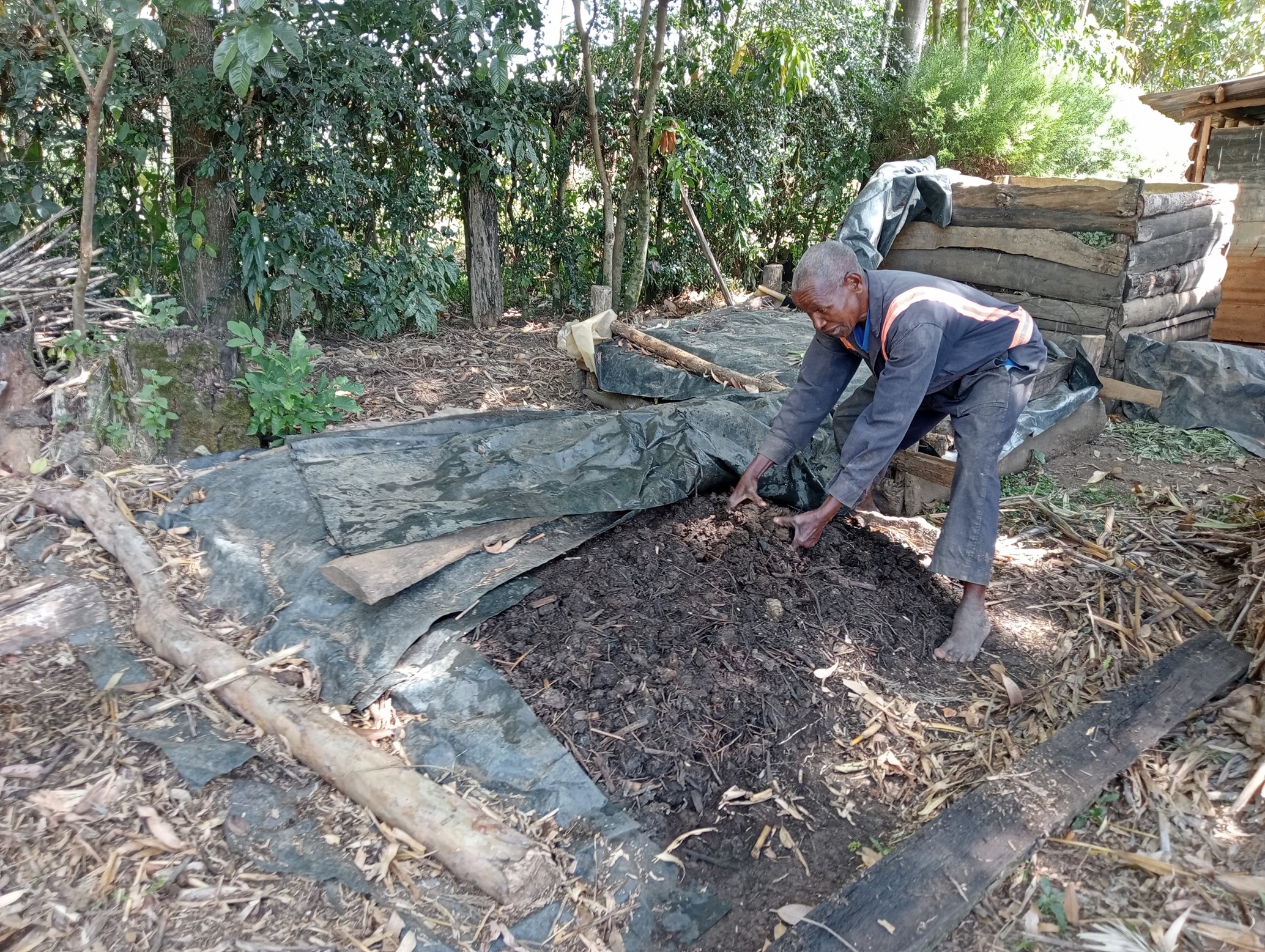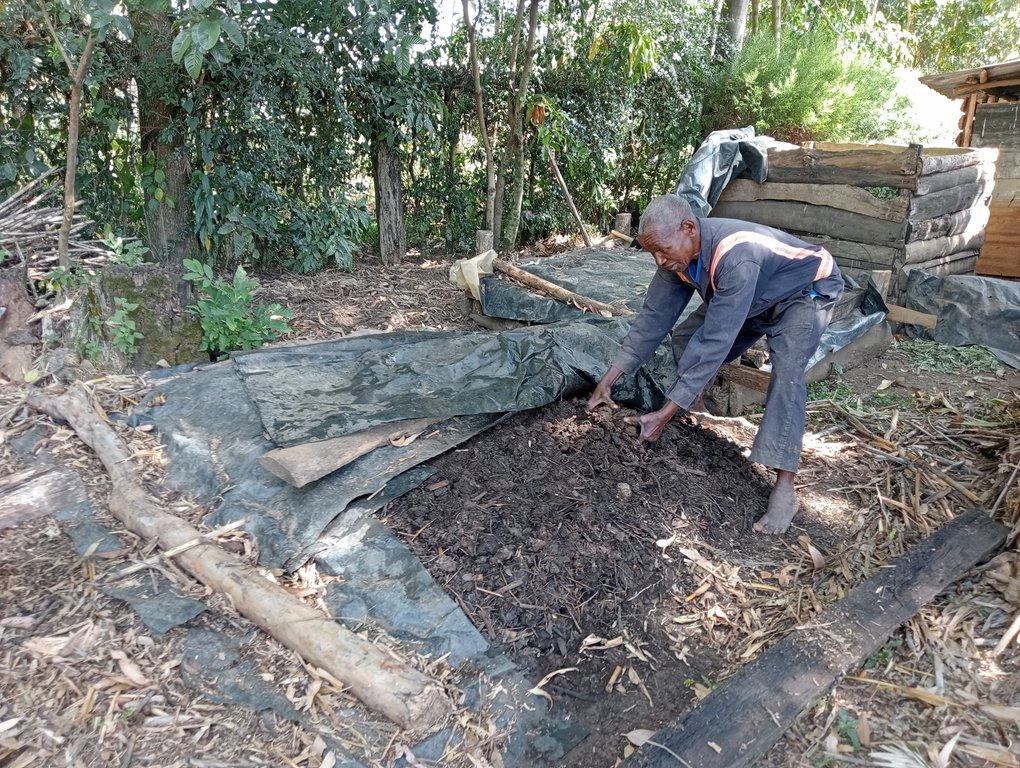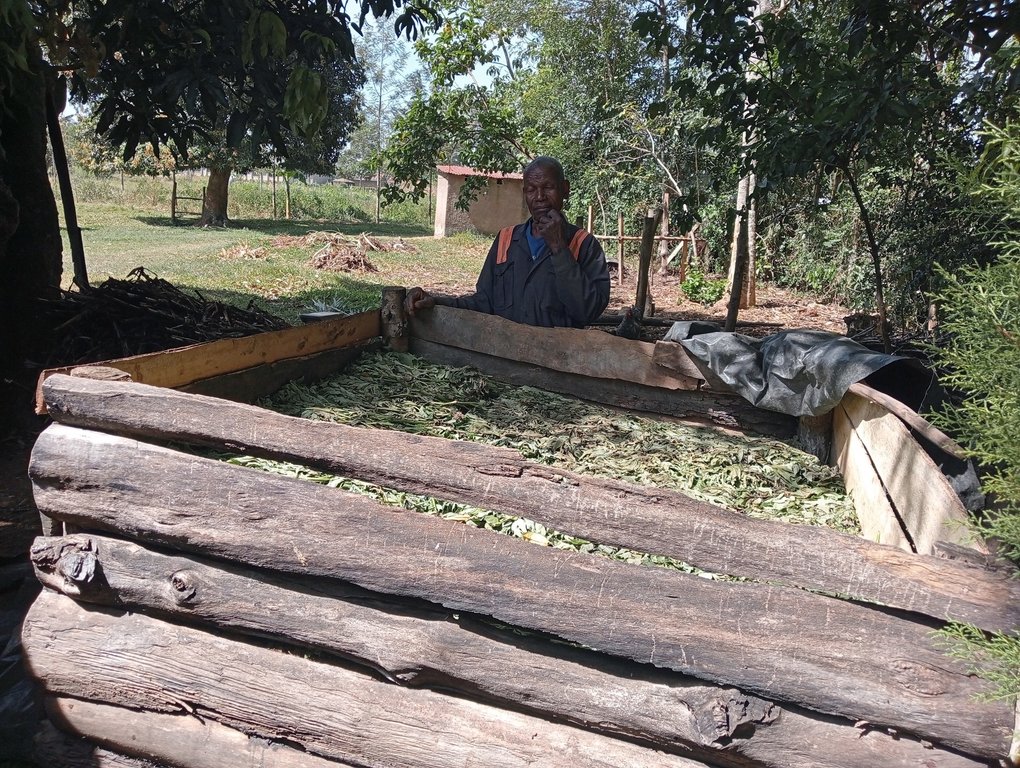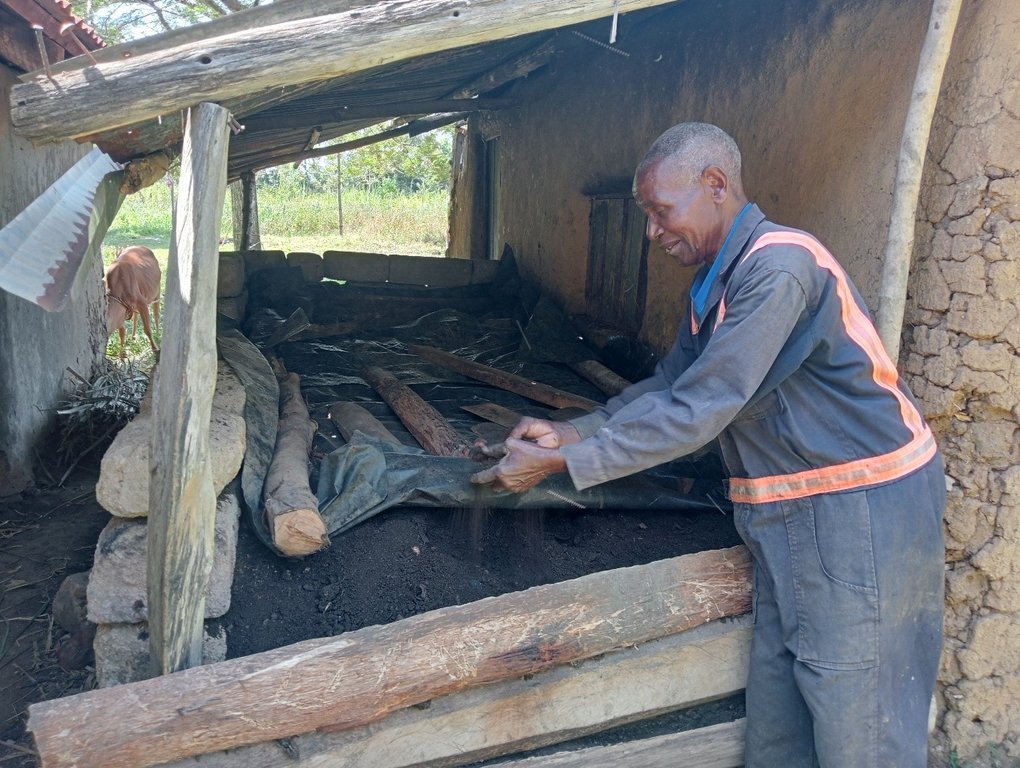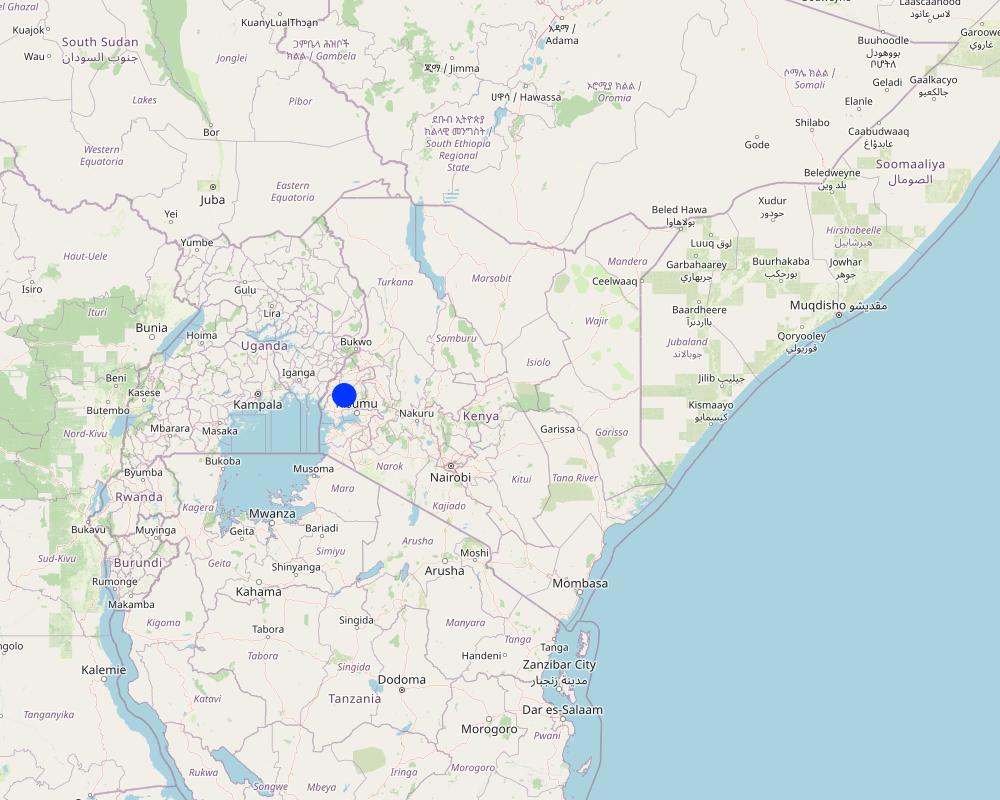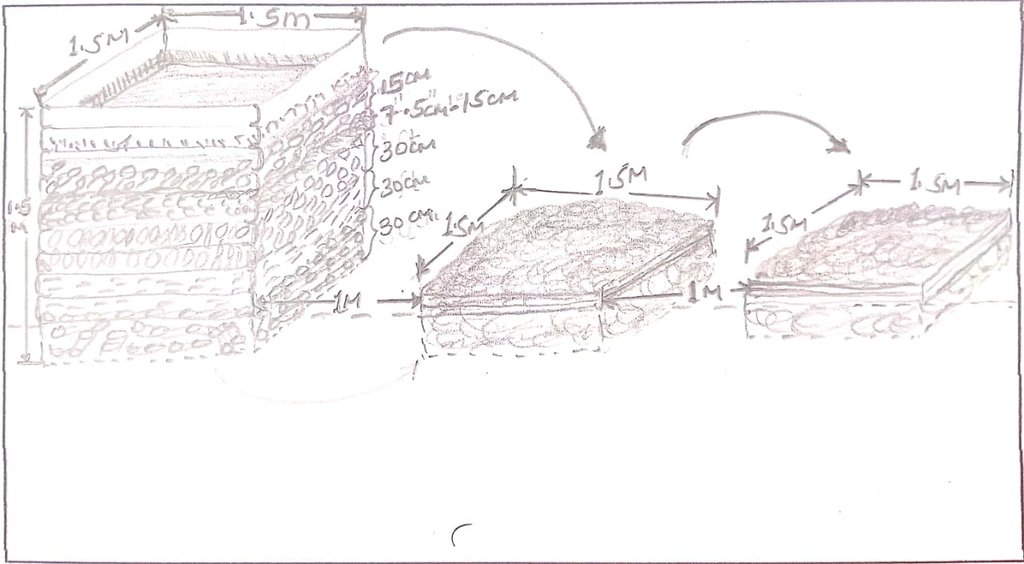Compost for organic waste management and improved crop yields [Quênia]
- Criação:
- Atualização:
- Compilador/a: William Akwanyi
- Editores: George Onyango, Innocent Faith, Noel Templer, Tabitha Nekesa, Ahmadou Gaye, Siagbé Golli
- Revisores: William Critchley, Rima Mekdaschi Studer, Sally Bunning
Mbolea bora (Kiswahili)
technologies_6648 - Quênia
Veja as seções
Expandir tudo Recolher tudo1. Informação geral
1.2 Detalhes do contato das pessoas capacitadas e instituições envolvidas na avaliação e documentação da tecnologia
Pessoa(s) capacitada(s)
usuário de terra:
Anyanga Matthews George
Welthungerhilfe
Quênia
Especialista em GST:
Especialista em GST:
Nome do projeto que facilitou a documentação/avaliação da Tecnologia (se relevante)
Soil protection and rehabilitation for food security (ProSo(i)l)Nome da(s) instituição(ões) que facilitou(ram) a documentação/ avaliação da Tecnologia (se relevante)
Deutsche Gesellschaft für Internationale Zusammenarbeit (GIZ)Nome da(s) instituição(ões) que facilitou(ram) a documentação/ avaliação da Tecnologia (se relevante)
Alliance Bioversity and International Center for Tropical Agriculture (Alliance Bioversity-CIAT) - Quênia1.3 Condições em relação ao uso da informação documentada através de WOCAT
O/a compilador/a e a(s) pessoa(s) capacitada(s) aceitam as condições relativas ao uso de dados documentados através da WOCAT:
Sim
1.4 Declaração de sustentabilidade da tecnologia descrita
A tecnologia descrita aqui é problemática em relação a degradação da terra de forma que não pode ser declarada uma tecnologia de gestão sustentável de terra?
Não
Comentários:
Farmers who have implemented the technology have recorded good harvests from their farms. The product of manure has improved their soils.
1.5 Referência ao(s) questionário(s) sobre abordagens GST (documentado(s) usando WOCAT)
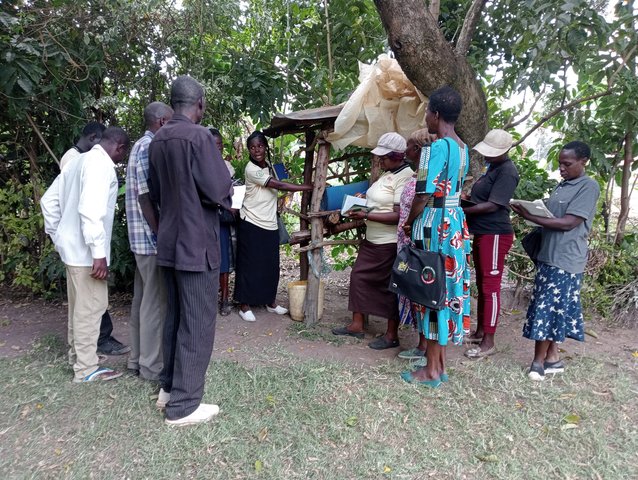
Community Resource Persons (CRP) in agricultural extension [Quênia]
Community Resource Persons (CRP) form a farmer-to-farmer learning approach that bridges the gap in agricultural extension, increases farmers' access to agricultural information (SLM knowledge), and increases the adoption of SLM practices.
- Compilador/a: William Akwanyi
2. Descrição da tecnologia de GST
2.1 Descrição curta da tecnologia
Definição da tecnologia:
Composting with on-farm organic solid waste management improves the soil sustainably and raises crop yields.
2.2 Descrição detalhada da tecnologia
Descrição:
Composting is a natural process of converting organic materials such as plant leaves, and food remains into a nutrient-rich soil-enhancing amendment called compost (if mainly from vegetative matter) or manure (if mainly from animal dung). It involves breaking organic matter down into humus/ compost by aerobic microorganisms - with by-products of water, heat, ammonia (NH3), and carbon dioxide (CO2). Humus is a dark and crumbly natural form of fertilizer applied to the soil to improve crop production. Composting is cost-effective since it can be made from locally available materials such as leaves, plant residues, food remains, cow dung, poultry droppings, animal urine, soil, etc. Composting is thus an on-farm solid waste management measure. When made correctly it can improve carbon sequestration in the soil (compost is carbon-rich) and prevent methane emissions (a greenhouse gas) since methane-producing microbes become inactive in aerobic conditions (in the presence of oxygen).
There are many ways of preparing compost. This method involves three key stages; mixing brown organic materials, such as twigs, and green materials, such as fresh leaves that are nitrogen-rich and moist. In the first stage, brown and green materials are layered, beginning with a 30 cm layer of twigs at the bottom, followed by a 30 cm layer of dry matter, such as maize straw chopped to a maximum of 7.5 cm. This is followed by a 30 cm layer of dry grass and dry leaves covered by a 7.5 cm – 15 cm layer of fresh cow dung. The fresh cow dung is covered by a 15 cm layer of fresh tithonia (an exotic plant) that is completely covered by a layer of ash and sprayed uniformly using 10 litres of animal urine and finally completely covered by a layer of soil or manure. All the above inputs except urine are sprayed with 10 – 20 litres of water. The pile is then completely covered with a black polythene sheet to help absorb heat, prevent the entry of rainwater, and prevent volatilization of nitrogen, i.e., the conversion of ammonium into ammonia gas, and left to decompose for 21 to 30 days.
The second stage involves mixing and transferring all the material except the twigs, to another space. The heap is again completely covered with a black polythene sheet to help absorb heat, prevent rainwater entry, and prevent nitrogen volatilization. It is again left to decompose for another 21 to 30 days. The third stage, like the second stage, involves completely mixing and transferring all the material from the second stage to another space and completely covering the heap with a black polythene sheet to help absorb heat and prevent the entry of rainwater. The contents are allowed to decompose for another 21 to 30 days, after which they are ready-to-use compost. The compost is stored under shade and covered with a black polythene sheet again to prevent nitrogen volatilization.
One heap of compost (first stage: 1.5 m by 1.5 m by 1.5 m) produces about 5 tonnes of ready-to-use compost. Composting takes about 90 days; hence, provided that all inputs are available, a farmer can produce compost 4 times each year from the same heaping point, i.e., about 20 tonnes. Normally, a 0.4-hectare farm requires about 20 tonnes of this compost. However, the amount varies from farm to farm depending on the conditions of the soil and the crop(s) to be grown. It is important that soil testing is done to determine the conditions of the soil to ensure that the compost is being used in the most effective manner.
Compost is carried to the farm on wheelbarrows and in buckets and is applied at the farm during planting time where a handful of compost is applied in the planting hole and mixed with soil before planting. It is again applied around the base of the crop and completely covered with soil. Preparation of compost in conservation agriculture situations could pose the problem of competition for plant material since plant material is used in conservation agriculture to cover the soil. To manage this, a farmer implementing both composting and conservation agriculture may have to acquire plant material for composting from other sources such as purchasing stover from other farmer who are not implementing conservation agriculture. In addition, the farmer could also use hedge trimmings as plant material for composting, especially if the farmer has a live fence.
2.3 Fotos da tecnologia
Observações gerais sobre as fotos:
Composting is a multi-stage process. The inputs/ materials in each stage must be completely covered with a black polythene sheet to help absorb heat, prevent the entry of rainwater, and prevent volatilization of nitrogen. The materials are allowed to decompose for at least 21 days in each stage before they are completely mixed and transferred to the next.
2.5 País/região/locais onde a tecnologia foi aplicada e que estão cobertos nesta avaliação
País:
Quênia
Região/Estado/Província:
Kakamega County in western Kenya
Especificação adicional de localização:
Elang'ata Village, Bulanda Sub-location, Imanga Location, Marama Central Ward, Butere Sub-county
Especifique a difusão da tecnologia:
- Aplicado em pontos específicos/concentrado numa pequena área
O(s) local(is) tecnológico(s) está(ão) localizado(s) em uma área permanentemente protegida?
Não
Comentários:
The farm where the technology is implemented is not in a protected area.
Map
×2.6 Data da implementação
Indique o ano de implementação:
2018
2.7 Introdução da tecnologia
Especifique como a tecnologia foi introduzida:
- atráves de inovação dos usuários da terra
- Como parte do sistema tradicional (>50 anos)
- através de projetos/intervenções externas
Comentários (tipos de projeto, etc.):
For years, the farmer has been converting farm wastes into manure. However, the Soil Protection and Rehabilitation of Degraded Soil for Food Security (ProSoil) project came in and taught them an improved method of composting that takes a shorter time compared with the traditional method, and prevents loss of nutrients during composting.
3. Classificação da tecnologia de GST
3.1 Principal/principais finalidade(s) da tecnologia
- Melhora a produção
- Reduz, previne, recupera a degradação do solo
- Adaptar a mudanças climáticas/extremos e seus impactos
- Atenuar a mudanças climáticas e seus impactos
- Criar impacto econômico benéfico
3.2 Tipo(s) atualizado(s) de uso da terra onde a tecnologia foi aplicada
Uso do solo misturado dentro da mesma unidade de terra:
Sim
Especificar o uso misto da terra (culturas/ pastoreio/ árvores):
- Agrossilvipecuária

Terra de cultivo
- Cultura anual
- Cultura perene (não lenhosa)
- Cultura de árvores e arbustos
Cultivo anual - Especificar culturas:
- culturas forrageiras - gramíneas
- cereais - milho
- legumes - outros
- Legumes e leguminosas - feijão
- culturas de raízes/tubérculos- mandioca
Sistema de cultivo anual:
Milho/sorgo/painço entremeado com legumes
Cultivo perene (sem lã) - Especificar culturas:
- banana/planta/abacá
Cultivo de árvores e arbustos - Especificar culturas:
- abacate
- frutas, outros
- manga, mangostão, goiaba
- mamão
Número de estações de cultivo por ano:
- 2
Especifique:
Long and short rain seasons
O cultivo entre culturas é praticado?
Sim
Em caso afirmativo, especifique quais são as culturas intercultivadas:
Maize and beans
O rodízio de culturas é praticado?
Sim
Caso afirmativo, especifique:
Some sections of the farm are left fallow during the short rains to allow for soil regeneration.

Pastagem
Pastagem intensiva/produção de forragem:
- Semiestabulação/sem pastagem
- Pastos melhorados
Tipo de animal:
- gado - lácteo
- gado - leite e carne bovina (por exemplo, zebu)
- aves
É praticado o manejo integrado de culturas e pecuária?
Sim
Caso afirmativo, especifique:
Cattle dung and poultry droppings are used as inputs in composting. Compost is applied on soil where livestock fodder is planted.
Produtos e serviços:
- segurança econômica, prestígio dos investimentos
- leite
- estrume como fertilizante/ produção de energia
- ovos
- carne
Espécie:
gado - lácteo
Contagem:
2
Espécie:
gado - leite e carne bovina (por exemplo, zebu)
Contagem:
3
Espécie:
aves
Contagem:
10
Comentários:
There are assorted trees on the farm, and these provide litter which is an input in composting.
3.3 O uso do solo mudou devido à implementação da Tecnologia?
O uso do solo mudou devido à implementação da Tecnologia?
- Não (Continuar com a pergunta 3.4)
3.4 Abastecimento de água
Abastecimento de água para a terra na qual a tecnologia é aplicada:
- Precipitação natural
Comentários:
Crops are planted only during the rainy seasons since there is no irrigation.
3.5 Grupo de GST ao qual pertence a tecnologia
- Gestão integrada plantação-criação de animais
- Gestão integrada de fertilidade do solo
- Gestão de resíduos/gestão de águas residuais
3.6 Medidas de GST contendo a tecnologia

Medidas agronômicas
- A2: Matéria orgânica/fertilidade do solo
- A6: Gerenciamento de resíduos
A6: Especificar o gerenciamento de resíduos:
A 6.3: coletado
Comentários:
Plant residues, especially leaves and soft branches are collected and used as input in composting. However, some plant matter is retained in the farm to naturally decompose and turn into manure at the farm. The farmer does not collect plant residues from protected areas. He has planted tithonia at some sections of the hedges at his farm; this provides the main source of tithonia. However, he sometimes harvests tithonia from his neighbours' hedges upon request.
3.7 Principais tipos de degradação da terra abordados pela tecnologia

Deteriorização química do solo
- Cn: declínio de fertilidade e teor reduzido de matéria orgânica (não causado pela erosão)
- Ca: acidificação
- Cp: poluição do solo
Comentários:
Covering of compost-making materials and the final compost reduces loss of nitrogen through volatilization of ammonium into ammonia gas. Compost raises the pH of soils when applied at the farm. Compost contains living organisms (bacteria and fungi) that degrade soil pollutants into non-toxic substances.
3.8 Redução, prevenção ou recuperação da degradação do solo
Especifique o objetivo da tecnologia em relação a degradação da terra:
- Prevenir degradação do solo
- Recuperar/reabilitar solo severamente degradado
Comentários:
Compost improves soil structure and porosity. Compost balances soil pH.
4. Especificações técnicas, implementação de atividades, entradas e custos
4.1 Desenho técnico da tecnologia
Especificações técnicas (relacionada ao desenho técnico):
Stage 1: about 30 cm deep under the ground, 1.5 m long by 1.5 m wide by 1.5 m high, including the 30 cm below the ground. Constructed using timber off-cuts (locally known as magogo) supported on posts at corners using nails. From bottom: 30 cm of twigs to extend some few inches above the ground to allow air circulation, 30 cm of dry matter e.g., maize straw chopped to 7.5 cm maximum, 30 cm dry grass and leaves, 7.5 cm - 15 cm layer of fresh cow dung, 15 cm layer of fresh tithonia, layer of ash, layer of soil or manure, black polythene sheet cover.
Stages 2 and 3: about 1-ft deep under the ground, 1.5 m long by 1.5 m wide, height depends on the volume of the material.
Allow space of no more than 1 m from one stage to the other for easy of mixing and transfer of materials from one stage to the next.
Autor:
William Onura
Data:
26/01/2023
4.2 Informação geral em relação ao cálculo de entradas e custos
Especifique como custos e entradas foram calculados:
- Por unidade de tecnologia
Especifique a unidade:
Heap of compost
Especificar as dimensões da unidade (se for relevante):
1.5 m by 1.5 m by 1.5 m
Outro/moeda nacional (especifique):
KES
Se for relevante, indique a taxa de câmbio do USD para moeda local (por exemplo, 1 USD = 79,9 Real): 1 USD =:
122,95
Indique a média salarial da mão-de-obra contratada por dia:
200
4.3 Atividades de implantação
| Atividade | Periodicidade (estação do ano) | |
|---|---|---|
| 1. | Digging of pits | At least 3 months before planting time |
| 2. | Framework construction with off cuts | At least 3 months before planting time |
| 3. | Filling stage one with inputs | At least 3 months before planting time |
Comentários:
Composting takes about 3 months; hence, the farmer should have the structures for composting at least 3 months before the planting time. A farmer can produce 20 tonnes of compost from 1 heap (1.5 m by 1.5 m by 1.5 m).
4.4 Custos e entradas necessárias para a implantação
| Especifique a entrada | Unidade | Quantidade | Custos por unidade | Custos totais por entrada | % dos custos arcados pelos usuários da terra | |
|---|---|---|---|---|---|---|
| Mão-de-obra | Framework construction | Man-days | 2,0 | 200,0 | 400,0 | 100,0 |
| Mão-de-obra | Filling inputs | Man-days | 1,0 | 200,0 | 200,0 | 100,0 |
| Equipamento | Jembe (hoe) | No. | 1,0 | 80,0 | 80,0 | |
| Equipamento | Spade | No. | 1,0 | 90,0 | 90,0 | |
| Equipamento | Fork hoe | No. | 1,0 | 70,0 | 70,0 | |
| Equipamento | Wheelbarrow | No. | 1,0 | 800,0 | 800,0 | |
| Equipamento | Hummer | No. | 1,0 | 100,0 | 100,0 | 100,0 |
| Equipamento | Handsaw | No. | 1,0 | 200,0 | 200,0 | 100,0 |
| Material vegetal | Twigs | Wheelbarrow | 2,0 | 100,0 | 200,0 | 100,0 |
| Material vegetal | Dry matter | Wheelbarrow | 6,0 | 50,0 | 300,0 | 100,0 |
| Material vegetal | Dry grass and leaves | 90 Kg sack | 3,0 | 50,0 | 150,0 | 100,0 |
| Material vegetal | Fresh tithonia | 90 Kg sack | 3,0 | 50,0 | 150,0 | 100,0 |
| Fertilizantes e biocidas | Ash | 90 Kg sack | 0,4 | 200,0 | 80,0 | 100,0 |
| Fertilizantes e biocidas | Animal urine | 10 litre container | 1,0 | 125,0 | 125,0 | 100,0 |
| Fertilizantes e biocidas | Soil or manure | Wheelbarrow | 1,0 | 300,0 | 300,0 | 100,0 |
| Fertilizantes e biocidas | Fresh cow dung | Wheelbarrow | 3,0 | 200,0 | 600,0 | 100,0 |
| Material de construção | Timber off-cuts | Pieces | 16,0 | 100,0 | 1600,0 | 100,0 |
| Material de construção | Wooden posts | Pieces | 4,0 | 50,0 | 200,0 | 100,0 |
| Material de construção | Nails (assorted sizes) | Kgs | 3,0 | 200,0 | 600,0 | 100,0 |
| Outros | Water | 20 litres container | 4,0 | 5,0 | 20,0 | 100,0 |
| Custos totais para a implantação da tecnologia | 6265,0 | |||||
| Custos totais para o estabelecimento da Tecnologia em USD | 50,96 | |||||
Se o usuário da terra arca com menos que 100% dos custos, indique quem cobre os custos remanescentes:
ProSoil project
Comentários:
The ProSoil project through Welthungerhilfe provided hoes, fork hoes, wheelbarrows, and spades to the farmers. The costs of these implements are KES 400/- for a hoe, KES 350/- for a fork hoe, KES 4,000/- for a wheelbarrow, KES 450/- for a spade, KES 500/- for a hummer, and KES 1,000/- for a handsaw. It is assumed that the farmer will be able to use the hoe, fork hoe, spade, hummer, and handsaw over a period of 5 years, and a wheelbarrow over a period of 10 years before these implements will have depreciated to a point where they will not be useable. The cost is thus spread over the years when the farmer will be able to use the implement.
4.5 Atividades recorrentes/manutenção
| Atividade | Periodicidade/frequência | |
|---|---|---|
| 1. | Turning at each stage | 21 - 30 days after start of each stage |
| 2. | Refilling at the first stage | At turning from the first stage |
| 3. | Distribution to the farm | When planting and at first weeding (i.e., 3rd week after planting) |
Comentários:
Turning involves complete mixing and transfer of the inputs from one stage to the next. Compost is applied at the farm during planting time where a handful of compost is applied in the planting hole and mixed with soil before planting. It is again applied around the base of the crop and completely covered with soil.
4.6 Custos e entradas necessárias pata a manutenção/atividades recorrentes (por ano)
| Especifique a entrada | Unidade | Quantidade | Custos por unidade | Custos totais por entrada | % dos custos arcados pelos usuários da terra | |
|---|---|---|---|---|---|---|
| Mão-de-obra | Complete mixing and turning from stage one to stage two and from stage two to stage three | Man-days | 4,0 | 200,0 | 800,0 | 100,0 |
| Mão-de-obra | Refilling with new materials at the first stage | Man-days | 1,0 | 200,0 | 200,0 | 100,0 |
| Mão-de-obra | Transfer to storage | Man-days | 2,0 | 200,0 | 400,0 | 100,0 |
| Mão-de-obra | Distribution to the farm | Man-days | 2,0 | 200,0 | 400,0 | 100,0 |
| Equipamento | Hoe | No. | 1,0 | 80,0 | 80,0 | |
| Equipamento | Fork hoe | No. | 1,0 | 90,0 | 90,0 | |
| Equipamento | Spade | No. | 1,0 | 70,0 | 70,0 | |
| Equipamento | Wheelbarrow | No. | 1,0 | 400,0 | 400,0 | |
| Material vegetal | Dry matter | Wheelbarrow | 6,0 | 50,0 | 300,0 | 100,0 |
| Material vegetal | Dry grass and leaves | 90Kg sack | 3,0 | 50,0 | 150,0 | 100,0 |
| Material vegetal | Fresh tithonia | 90Kg sack | 3,0 | 50,0 | 150,0 | 100,0 |
| Fertilizantes e biocidas | Ash | 90 Kg sack | 0,4 | 200,0 | 80,0 | 100,0 |
| Fertilizantes e biocidas | Animal urine | 10 litre container | 1,0 | 125,0 | 125,0 | 100,0 |
| Fertilizantes e biocidas | Soil or manure | Wheelbarrow | 1,0 | 300,0 | 300,0 | 100,0 |
| Fertilizantes e biocidas | Fresh cowdung | Wheelbarrow | 3,0 | 200,0 | 600,0 | 100,0 |
| Outros | Water | 20 litres container | 4,0 | 5,0 | 20,0 | 100,0 |
| Custos totais para a manutenção da tecnologia | 4165,0 | |||||
| Custos totais de manutenção da Tecnologia em USD | 33,88 | |||||
Se o usuário da terra arca com menos que 100% dos custos, indique quem cobre os custos remanescentes:
ProSoil project
Comentários:
The hoes, fork hoes, wheelbarrows, and spades provided by the ProSoil project through Welthungerhilfe are fixed assets and are used for years by the farmer before they can wear out. The farmer can use these implements for other work at the farm. The costs of these implements are KES 400/- for a hoe, KES 350/- for a fork hoe, KES 4,000/- for a wheelbarrow, and KES 450/- for a spade. It is assumed that the farmer will be able to use the hoe, fork hoe, and spade over a period of 5 years, and a wheelbarrow over a period of 10 years before these implements will have depreciated to a point where they will not be useable. The cost is thus spread over the years when the farmer will be able to use the implement. The twigs are reused during the refilling process since they take long to decompose.
4.7 Fatores mais importantes que afetam os custos
Descreva os fatores mais determinantes que afetam os custos:
Rate of man-days vary from one place to another. It is not easy to attach monetary value to some of the input e.g., animal urine, cow dung, and water.
Exchange rate for January 2023, source: European Commission/ InfoEuro online at https://commission.europa.eu/funding-tenders/procedures-guidelines-tenders/information-contractors-and-beneficiaries/exchange-rate-inforeuro_en
5. Ambiente natural e humano
5.1 Clima
Precipitação pluviométrica anual
- <250 mm
- 251-500 mm
- 501-750 mm
- 751-1.000 mm
- 1.001-1.500 mm
- 1.501-2.000 mm
- 2.001-3.000 mm
- 3.001-4.000 mm
- > 4.000 mm
Especificações/comentários sobre a pluviosidade:
Monthly rainfall variability is high with some months such as January recording less than 5 mm of total rainfall.
Indique o nome da estação meteorológica de referência considerada:
Kakamega Meteorological Station
Zona agroclimática
- úmido
The climate in the area favours most agricultural activities.
5.2 Topografia
Declividade média:
- Plano (0-2%)
- Suave ondulado (3-5%)
- Ondulado (6-10%)
- Moderadamente ondulado (11-15%)
- Forte ondulado (16-30%)
- Montanhoso (31-60%)
- Escarpado (>60%)
Formas de relevo:
- Planalto/planície
- Cumes
- Encosta de serra
- Encosta de morro
- Sopés
- Fundos de vale
Zona de altitude:
- 0-100 m s.n.m.
- 101-500 m s.n.m.
- 501-1.000 m s.n.m.
- 1.001-1.500 m s.n.m.
- 1.501-2.000 m s.n.m.
- 2.001-2.500 m s.n.m.
- 2.501-3.000 m s.n.m.
- 3.001-4.000 m s.n.m.
- > 4.000 m s.n.m.
Indique se a tecnologia é aplicada especificamente em:
- Não relevante
Comentários e outras especificações sobre a topografia:
The farm is located at an area that is higher in altitude compared to other areas in the larger area. The average altitude for the area is 1,350m above sea level but the farm is at 1,401m above sea level.
5.3 Solos
Profundidade do solo em média:
- Muito raso (0-20 cm)
- Raso (21-50 cm)
- Moderadamente profundo (51-80 cm)
- Profundo (81-120 cm)
- Muito profundo (>120 cm)
Textura do solo (solo superficial):
- Médio (limoso, siltoso)
Textura do solo (>20 cm abaixo da superfície):
- Grosso/fino (arenoso)
Matéria orgânica do solo superficial:
- Médio (1-3%)
Caso disponível anexe a descrição completa do solo ou especifique as informações disponíveis, p. ex. tipo de solo, PH/acidez do solo, nitrogênio, capacidade de troca catiônica, salinidade, etc.
Soil pH of most farms in the area ranges from moderately acid (5.50) to moderately alkaline (7.80).
5.4 Disponibilidade e qualidade de água
Lençol freático:
5-50 m
Disponibilidade de água de superfície:
Bom
Qualidade da água (não tratada):
Água potável precária (tratamento necessário)
A qualidade da água refere-se a:
tanto de águas subterrâneas quanto de superfície
A salinidade da água é um problema?
Não
Ocorre inundação da área?
Não
Comentários e outras especificações sobre a qualidade e a quantidade da água:
There are several boreholes in the area and according to interviews with some borehole owners, the depts are not more than 50 metres.
5.5 Biodiversidade
Diversidade de espécies:
- Médio
Diversidade de habitat:
- Médio
Comentários e outras especificações sobre biodiversidade:
The area has high agrobiodiversity since most farms are under crops and trees.
5.6 Características dos usuários da terra que utilizam a tecnologia
Sedentário ou nômade:
- Semi-nômade
Orientação de mercado do sistema de produção:
- misto (subsistência/comercial)
Rendimento não agrícola:
- >50% de toda renda
Nível relativo de riqueza:
- Média
Indivíduos ou grupos:
- Indivíduo/unidade familiar
Nível de mecanização:
- Trabalho manual
- Tração animal
Gênero:
- Mulheres
- Homens
Idade dos usuários da terra:
- Jovens
- meia-idade
- idosos
Indique outras características relevantes dos usuários da terra:
The farmer uses the land together with his other family members.
5.7 Área média de terrenos utilizados pelos usuários de terrenos que aplicam a Tecnologia
- < 0,5 ha
- 0,5-1 ha
- 1-2 ha
- 2-5 ha
- 5-15 ha
- 15-50 ha
- 50-100 ha
- 100-500 ha
- 500-1.000 ha
- 1.000-10.000 ha
- > 10.000 ha
É considerado pequena, média ou grande escala (referente ao contexto local)?
- Média escala
Comentários:
Farmers with more than 2 ha in the area are considered to have large pieces of land since there is high level of land fragmentation in the area.
5.8 Propriedade de terra, direitos de uso da terra e de uso da água
Propriedade da terra:
- Indivíduo, não intitulado
- Indivíduo, intitulado
Direitos do uso da terra:
- Arrendado
- Indivíduo
Direitos do uso da água:
- Acesso livre (não organizado)
- Indivíduo
Os direitos de uso da terra são baseados em um sistema jurídico tradicional?
Não
Especifique:
Each landowner has full control of the way he/ she wants to use his/ her land.
Comentários:
The farmer has an official ownership title for his piece of land. He also leases other people's pieces of land for farming. Water in the streams and springs is freely accessed without restrictions. There is a borehole in the neighbourhood, and the managers of this borehole have set rules for accessing the water thereat.
5.9 Acesso a serviços e infraestrutura
Saúde:
- Pobre
- Moderado
- Bom
Educação:
- Pobre
- Moderado
- Bom
Assistência técnica:
- Pobre
- Moderado
- Bom
Emprego (p. ex. não agrícola):
- Pobre
- Moderado
- Bom
Mercados:
- Pobre
- Moderado
- Bom
Energia:
- Pobre
- Moderado
- Bom
Vias e transporte:
- Pobre
- Moderado
- Bom
Água potável e saneamento:
- Pobre
- Moderado
- Bom
Serviços financeiros:
- Pobre
- Moderado
- Bom
Comentários:
The above rating varies from one village to the other.
6. Impactos e declarações finais
6.1 Impactos no local mostrados pela tecnologia
Impactos socioeconômicos
Produção
Produção agrícola
Quantidade anterior à GST:
Less than 4
Quantidade posterior à GST:
More than 8
Comentários/especificar:
Quantity refers to the number of 90 Kg bags of maize produced per acre. Based on measurement by the farmer.
Qualidade da safra
Comentários/especificar:
Not easy to quantify. The crops do better compared to how they could do in the past, yet he does not use inorganic fertilizers. Based on estimation by the farmer.
Produção de forragens
Quantidade anterior à GST:
2
Quantidade posterior à GST:
3 - 4
Comentários/especificar:
Quantity refers to harvesting cycles for nappier grass from the same farm. He applies compost on the pieces of land where he has grown fodder. The fodder does better than how it used to do before when he was not applying compost.
Qualidade da forragem
Comentários/especificar:
He applies compost on the pieces of land where he has grown fodder.
Produção animal
Quantidade anterior à GST:
1 - 3
Quantidade posterior à GST:
3 - 10
Comentários/especificar:
Quantity refers to the amount of milk in litres from one cow. He gets more milk from his cows as compared to what he used to get before the SLM since applying compost on the pieces of land where he has grown fodder makes the fodder to grow faster. Milk production is often at the peak during early lactation months.
Risco de falha de produção
Quantidade anterior à GST:
Over 50
Quantidade posterior à GST:
Less than 10
Comentários/especificar:
Quantity refers to the percentage probability of the crop failing to do well. Quote from the farmer, '... it was 50 50 getting any produce before I started using compost ...' meaning that there was high chance that the crop could fail due to poor soils. Compost is a rich source of organic matter; hence, ensure sustainable agricultural production.
Renda e custos
Despesas com insumos agrícolas
Quantidade anterior à GST:
Over 5,000
Quantidade posterior à GST:
0
Comentários/especificar:
Quantity refers to the amount of money in Kenya shillings spend on inorganic fertilizers in a season. The farmers no longer spend money inorganic fertilizers.
Rendimento agrícola
Quantidade anterior à GST:
Less than 2,000
Quantidade posterior à GST:
20,000
Comentários/especificar:
Quantity refers to the amount of money in Kenya shillings received from the sale of farm produce, including compost in a year. The farmer is able to sell surplus crop and animal products as a result of bumper harvest due to the use of compost on his farm.
Diversidade de fontes de rendimento
Quantidade anterior à GST:
1 - 3
Quantidade posterior à GST:
More than 3
Comentários/especificar:
Quantity refers to household income sources, including sale of surplus farm produce and compost. The farmer is able to sell surplus crop and animal products, and other on-farm products such and compost.
Carga de trabalho
Quantidade anterior à GST:
Over 5
Quantidade posterior à GST:
Less than 1
Comentários/especificar:
Quantity refers to the number of hours that the farmer can be free in any working day. A lot of work is involved in the preparation and maintenance of compost in order to achieve the desired results.
Impactos socioculturais
Segurança alimentar/auto-suficiência
Quantidade anterior à GST:
About 3 months of purchasing maize
Quantidade posterior à GST:
No months when there is total lack of food in the house
Comentários/especificar:
Quantity refers to the number of months in a year when there is total lack of food in the house, and the farmer has to buy all the food required in the house. The soils at the farm have been enhanced; hence, the farmer grows a variety of crops. Food is available in the household to sustain the family from one harvest to the next.
Conhecimento de GST/ degradação da terra
Quantidade anterior à GST:
10%
Quantidade posterior à GST:
Over 90%
Comentários/especificar:
Quantity refers to the estimated percentage of knowledge in SLM/ land management. Not only is the farmer equipped with skills on how to make compost but also with skills in other SLM technologies such as vermicomposting.
Impactos ecológicos
Solo
Umidade do solo
Quantidade anterior à GST:
Less than 10
Quantidade posterior à GST:
20 or more
Comentários/especificar:
Quantity refers to the farmer's estimated soil moisture content during the dry season when soil moisture challenges are expected to be high.
Cobertura do solo
Quantidade anterior à GST:
30 - 50
Quantidade posterior à GST:
60 - 80
Comentários/especificar:
Quantity refers to the farmer's estimated percentage soil cover at the farm.
Matéria orgânica do solo/carbono abaixo do solo
Comentários/especificar:
Quantity refers to the farmer's estimated percentage of organic matter at the farm. Based on estimation by the farmer.
Biodiversidade: vegetação, animais
Cobertura vegetal
Quantidade anterior à GST:
30 - 50
Quantidade posterior à GST:
60 - 80
Comentários/especificar:
Quantity refers to the farmer's estimated percentage vegetation cover at the farm.
Diversidade vegetal
Quantidade anterior à GST:
About 3
Quantidade posterior à GST:
More than 5
Comentários/especificar:
Quantity refers to the number of plants (crops) that the farmer establishes at the farm.
Espécies benéficas
Comentários/especificar:
Not easy to quantify but the number of earthworms in the farm and bees visiting the farm to look for nectar has increased.
Diversidade de habitat
Comentários/especificar:
Not easy to quantify but the number of earthworms in the farm has increased which is an indication of increased habitats for different animals at the farm.
Especificar a avaliação dos impactos no local (medidas):
No recorded data is available for reference. All are estimates based on the farmer's explanation or as given by him.
6.2 Impactos externos mostrados pela tecnologia
Danos em áreas vizinhas
Quantidade anterior à GST:
80
Quantidade posterior à GST:
10
Comentários/especificar:
Quantity refers to the probability of the neighbours' farms being burned because of available plant residues. The farmer collects residues from his neighbours' farms for use in composting. The neighbours could have burned the residues leading to death of useful microorganisms (bacteria and fungi).
Impacto dos gases de efeito estufa
Comentários/especificar:
Not easy to quantify. Composting improves carbon sequestration in the soil and by preventing methane emissions through aerobic decomposition, as methane-producing microbes are not active in aerobic conditions.
Especificar a avaliação dos impactos fora do local (medidas):
No recorded data is available for reference. All are estimates based on the farmer's explanation or as given by him.
6.3 Exposição e sensibilidade da tecnologia às mudanças climáticas graduais e extremos/desastres relacionados ao clima (conforme o ponto de vista dos usuários da terra)
Mudança climática gradual
Mudança climática gradual
| Estação do ano | aumento ou diminuição | Como a tecnologia lida com isso? | |
|---|---|---|---|
| Temperatura sazonal | estação úmida/das chuvas | redução/diminuição | bem |
Extremos (desastres) relacionados ao clima
Desastres climatológicos
| Como a tecnologia lida com isso? | |
|---|---|
| Queimada | bem |
Comentários:
Flammable plant residues are used as inputs in composting and, thus, the risk of fire is reduced.
6.4 Análise do custo-benefício
Como os benefícios se comparam aos custos de implantação (do ponto de vista dos usuários da terra)?
Retornos a curto prazo:
levemente positivo
Retornos a longo prazo:
muito positivo
Como os benefícios se comparam aos custos recorrentes/de manutenção(do ponto de vista dos usuários da terra)?
Retornos a curto prazo:
muito positivo
Retornos a longo prazo:
muito positivo
Comentários:
Use of compost reduces the dependence on inorganic fertilizers.
6.5 Adoção da tecnologia
- 11-50%
Se disponível, determine a quantidade (número de unidades familiares e/ou área abordada):
The project was implemented in the entire ward. Most farmers are preparing compost as advised in the ProSoil project.
De todos aqueles que adotaram a Tecnologia, quantos o fizeram espontaneamente, ou seja, sem receber nenhum incentivo/ pagamento material?
- 91-100%
Comentários:
Most farmers are able to implement since the investment cost is not very high.
6.6 Adaptação
A tecnologia foi recentemente modificada para adaptar-se as condições variáveis?
Não
6.7 Pontos fortes/vantagens/oportunidades da tecnologia
| Pontos fortes/vantagens/oportunidades na visão do usuário da terra |
|---|
| With continued use of compost, there is no need for expensive inorganic fertilizers and pesticides that could also contaminate/ degrade the soil. |
| Composting is not capital intensive. |
| Pontos fortes/vantagens/oportunidades na visão do/a compilador/a ou de outra pessoa capacitada |
|---|
| There is high production in the long run even without use of inorganic fertilizers. |
| Composting is not capital intensive. |
6.8 Pontos fracos, desvantagens/riscos da tecnologia e formas de superá-los
| Pontos fracos/desvantagens/riscos na visão do usuário da terra | Como eles podem ser superados? |
|---|---|
| Inputs such as tithonia are not easy to find. | Farmers can plant tithonia as hedges on their farms. |
| More labour intensive as compared to the traditional way of composting. | Farmers have to be committed. |
| Pontos fracos/vantagens/riscos na visão do/a compilador/a ou de outra pessoa capacitada | Como eles podem ser superados? |
|---|---|
| More labour intensive. | Proper planning/ scheduling of farmm activities. |
7. Referências e links
7.1 Métodos/fontes de informação
- visitas de campo, pesquisas de campo
One visit at one farm
- entrevistas com usuários de terras
One farmer interviewed at his farm. Follow-up questions on phone.
- entrevistas com especialistas em GST
ProSoil team and project implementers from Welthungerhilfe consulted.
- compilação de relatórios e outra documentação existente
Kakamega County Integrated Development Plan, 2018-2022 and online sources reviewed.
Quando os dados foram compilados (no campo)?
26/01/2023
Comentários:
One field visit and several follow-up consultations.
7.2 Referências às publicações disponíveis
Título, autor, ano, ISBN:
Comparative effectiveness of different composting methods on the stabilization, maturation and sanitization of municipal organic solid wastes and dried faecal sludge mixtures, Mengistu, T., Gebrekidan, H., Kibret, K. et al., 2018, Environ Syst Res 6, 5 (2018)
Disponível de onde? Custos?
Free download at https://doi.org/10.1186/s40068-017-0079-4
7.3 Links para informações on-line relevantes
Título/ descrição:
Composting Recycling Naturally: Simple Steps for Starting at Home
URL:
https://scdhec.gov/sites/default/files/Library/OR-1705.pdf
7.4 Comentários gerais
1. Provide a function to be able to link the documented SLM to similar work that has been documented in other databases e.g., LandPortal, UNCCD, etc.
2. Some of the impacts (section 6) cannot be quantified.
Links e módulos
Expandir tudo Recolher tudoLinks

Community Resource Persons (CRP) in agricultural extension [Quênia]
Community Resource Persons (CRP) form a farmer-to-farmer learning approach that bridges the gap in agricultural extension, increases farmers' access to agricultural information (SLM knowledge), and increases the adoption of SLM practices.
- Compilador/a: William Akwanyi
Módulos
Não há módulos


